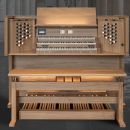Bückeburg Stadtkirche
The town church of Bückeburg had an organ by Esaias Compenius the Older, completed in 1617. During the centuries, the organ was changed many times. In 1962, the organ was completely destroyed by fire. The organ was recreated in its putative original form in 1965 by Emil Hammer, after the disposition noted by Michael Praetorius.
Janke, 1997 3 manuals 47 stops
History
A new organ was built into the case thirty years later by Rudolf Janke, his opus 114, in the style of Mid-German baroque, reusing some elements of the Hammer organ. The organ is a free interpretation of the old concept of Compenius, and it wittnesses the legacy of the finest neo-baroque organbuilding practices of the late 20th century. Its refined voicing is highly praised by experts and its crisp sound can be admired by organ enthusiasts. The organ is designed on 3 manuals and a pedal, each division having its own principal chorus (Werkprinzip) and a multitude of solo voices. There are 47 speaking stops in total.

Bückeburg Stadtkirche
Specifications
General
- Janke, 1997
- 3 Manuals
- 47 Stops

































